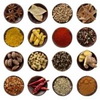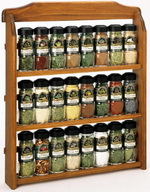|
Herbs and Spices – Making Those Recipes Absolutely Delicious

Herbs and spices are a key ingredient to making our foods taste great. There is almost no food in its final cooked form that doesn’t contain some herb or spice. Herbs and spices have been used for thousands of years to make food taste more appetizing. What was once something afforded only by the rich can now be enjoyed by everyone.
History
The first known use of spices and herbs dates from the age of the pyramids in Egypt around 2600 to 2100 BCE, when onions and garlic are alleged to have been fed to the slaves that were used to build the Great Period of Cheops for their medicinal properties and to preserve the health of these workers. Certain spices and herbs were also stated to have been used in the embalming process.
Later in the Egyptian culture at around 1500 BCE the records show that Egyptians were now using spices and herbs for cosmetics, perfumes, cooking and fumigation in addition to their uses in medicine and embalming.
At around 1000 BCE Arabian traders as they traveled from West to East profited greatly from the spice trade creating a price monopoly by claiming that the spices that they sold came from somewhere else so that others couldn’t get in on the trade.
By the time that the Dark Ages were reached at around 900 AD spices in use in the everyday lives of the common folks was unheard of, with the Church having the monopoly on the use and cultivation of this precious commodity.
By 1200 AD spices such as peppercorns were being used like money, and by 1600 AD the East India Company was founded and around 1602 the Dutch East India Company was founded opening the era of a new spice empire. Around AD 1800 the United States entered the spice trade and our love and use of spices along with the rest of the world continues to the present day, and although many spices and herbs continue to be manufactured in a variety of traditional ways, there are modern and convenient methods of production that make the purchase and use of spices and herbs affordable for everyone.
What Are Herbs and Spices?
Spices and herbs really are often different parts of the same plant, for example herbs are derived from the leaves of the plant and spices are derived from the bark, roots, stems and seeds of the plant after they have been dried and ground to a powder, which is when the aromatic oils of the plants are released as spices and give off their most potent smells to titillate the senses.
Common Spices and Herbs
Allspice For an interesting free course on cooking with herbs and spices click on the link to suite101.com
For some great sections on herbs and spices some great references are:
• The Spice and Herb Bible – Second Edition by Ian Hemphill with recipes by Kate Hemphill
• The Food Encyclopedia by Jacques L. Rolland and Carol Sherman with other contributors
Cooking and Nutrition
|
The Spice Rack

Families of Spice
Myrtle Family
Allspice
Cloves
Parsley Family
Aniseed
Caraway
Celery Seed
Coriander
Cumin
Dill
Fennel
Parsley
Mint Family
Basil
Marjoram
Mint
Oregano
Rosemary
Sage
Savory
Thyme
Laurel Family
Bay Leaf
Cinnamon
Ginger Family
Cardamom (Green and Black)
Ginger
Turmeric
Nightshade Family
Chili
Paprika
Onion Family
Chives
Garlic
Citrus Family
Curry Leaves
Cabbage Family
Horseradish
Mustard
Grass Family
Lemon Grass
Bean Family
Licorice
Tamarind
Nutmeg Family
Mace
Nutmeg
Pepper Family
Pepper (black, white, green, red)
Poppy Family
Poppy Seed
Daisy Family
Safflower
Tarragon
Iris Family
Saffron
Sesame Family
Sesame
Orchid Family
Vanilla
Amaranth Family
Epazote
Then there is Salt in a class by itself, which isn't a spice at all, but a unique chemical compound that adds great flavor to our foods.






